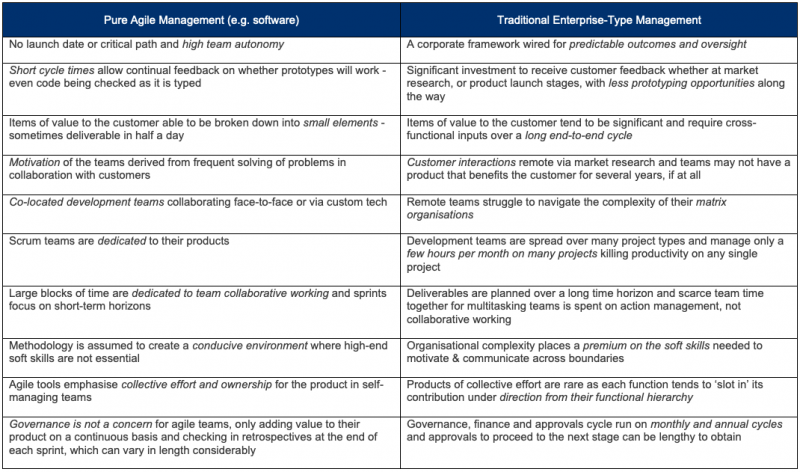Using Agile Techniques In Life Sciences & CPG
Learnings From The Last Great Methodology Import
Why can technology products launch in just a few months, when life science and consumer packaged goods (CPG) companies often have nothing to show for their teams’ efforts after years? This has driven many to look to the appealing methodology that’s driving software to market and ask if it can be successfully applied in organisations and markets that run very differently. Here we take a look back at the last great methodological import and the lessons we can learn for application of agile techniques.
Beginning in the 1990s, a new ‘wonder method’ began to cause waves in Western multinationals as the adoption of ‘lean’ techniques were introduced. Exemplified by the Toyota Way, the promises of waste reduction, quality improvements and supply chain and customer responsiveness were irresistible for many. However, the results achieved were often mixed and sustainability of the change was a particular problem.
Subsequent studies have shown that beyond the initial enthusiasm, there was often bafflement amongst front-line workers implementing the changes. Western companies had studied and aped the methods and tools, but had missed the major differences in context and culture that underpinned the methods in Japan. Not only was the whole Japanese business sector financed differently by the banks, but the tools relied heavily on embracing a culture particular to those organisations and that region.
Without the culture, the tools made limited headway. Spot improvements could be made. Really sustained changes were hard won in some industries, notably car production and the food supply chain in the West, but elsewhere the dominant modes of thinking and working delivered more tactical improvements. It required front-line workers to accept high degrees of standardisation in the way work was done, in exchange for sufficient self-actualisation being possible through small, regimented contributions to improving that way of working.
Are the same difficulties being experienced in adopting agile project management principles in industries with very different cultures and operating models to software engineering? What are the cultural and industry factors that the best have overcome to realise benefits from agile project working? From speaking with those at the cutting edge of agile delivery in software, these are the headwinds that organisations must contend with:
Figure 1. What are the headwinds in translating agile across boundaries?
How do those successful in adopting agile techniques approach these challenges, if we accept the context and culture (driven by a very different product, price, and place), are indeed hard to reconcile:
- Consider dedicating teams to a product, initiative or group of initiatives to allow them to develop a culture and way of operating that is agile compatible
- Ensure teams have sufficient regular collaboration time together, either face to face, or via excellent digital collaboration tools – an hour per week will not cut it
- Allow greater autonomy by insulating teams from the matrix structure and empowering them to make their own decisions on how to gauge value is being added continually
- Ask how small can we split things to learn fast if it won’t work?
- Disrupt the innovation governance structure and don’t try to force-fit agile to existing stage-gate structures (at least until you are ready for scaling up a validated product)
- Instead focus on Minimum Viable Products (MVPs) and quickly reaching learning events rather than stage gates
- The best can be ambidextrous at running agile projects alongside the traditional model; it should be complementary rather than sweeping away established value
- If you rely on traditional organisational structures, you will get ‘functional led innovation’, but those who build the organisation for each new innovation get ‘innovation led functions’
- Be prepared to look outside of the usual talent structures to find the right people – the leaders, super connectors, technology integrators, tech entrepreneurs etc.
- Celebrate examples of role-model agile working and cultivate champions who can spread the benefits
- As with any methodology, soft skills will still form the greater art of an effective toolkit
When starting your journey into agile, here are our recommended steps:
- Evaluate specific context / culture / product and define the objectives
- Select the appropriate projects to pilot (considering the table above)
- Equip teams with the right tools, training and sponsors to run the pilot
- Formally review and get the objective learnings from the pilot
- Draw the boundaries around what will be run as before, and what space needs to be protected to allow agile teams freedom to succeed
- Train, embed, codify and sponsor
At Skarbek, we recognise there is no one right methodology for managing projects and it can be really counterproductive to rush to a methodology because it is more fashionable. We have found those who succeed have an informed ‘best of both’ approach that can work well if the context and culture are carefully considered in selecting which elements of agile will work well where and avoiding projects which will simply cause frustration. Senior leaders need to be prepared to give more autonomy and avoid salami-slicing resources across the organisational matrix if agile, and the promise of faster delivery, is to take hold.
Finally, someone has to do the hard work of fitting your new agile ways of working into the corporate cycle, to ensure the capability does not peter out after some early wins due to the incompatibly of the two systems. Regardless of the methodology we use, it is the humans, their trust, mindset and collaborative ability as a team that truly makes the difference.
